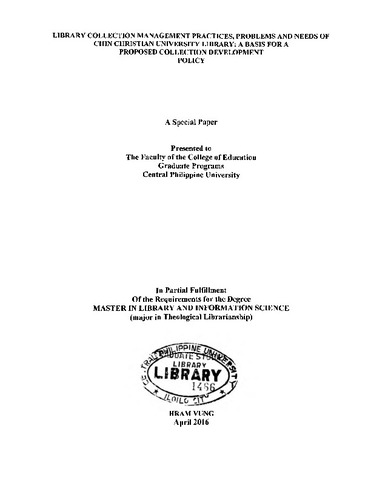Assessment of the quality services of libraries of state universities and colleges in Iloilo City
| dc.contributor.adviser | Fernandez, Josephine T. | |
| dc.contributor.author | Dorado, Rafaelyn P. | |
| dc.coverage.spatial | Iloilo | en_US |
| dc.date.accessioned | 2021-03-17T06:22:32Z | |
| dc.date.available | 2021-03-17T06:22:32Z | |
| dc.date.issued | 2010 | |
| dc.identifier.citation | Dorado, R. P. (2010). Assessment of the quality services of libraries of state universities and colleges in Iloilo City (Unpublished Master's thesis). Central Philippine University, Jaro, Iloilo City. | en_US |
| dc.identifier.uri | https://hdl.handle.net/20.500.12852/611 | |
| dc.description | Abstract only | en_US |
| dc.description.abstract | State Universities and Colleges libraries and like any other types of libraries plays a major role of providing adequate information towards the development of research and instruction in the academic community. It is considered as the heart of the institution whose purpose is to assist clients in using knowledge and technology to improve their lives. Geared towards this purpose, there is a need for constant assessment and evaluation to demonstrate institutional effectiveness and foster institutional improvement. Like any other learning institutions, state universities and colleges also submit themselves for voluntary evaluation by accrediting agencies to establish its strength and weaknesses and in whatever aspects that need development. This will allow the institutions to keep abreast of the standard of excellence in which they should strive to attain. With the advent of new technology, libraries are facing major threats such as global digital environment and increasing competition in terms of their services. It is for the desire of offering quality library services to clients that state universities and colleges endeavor to continue strengthening their resources to satisfy such need. The purpose of this study was to answer the following questions such as determine: the characteristics of the respondents as to their age, gender, library user group and frequency of library visits; the respondents’ utilization of library services and their perceived quality of library services. Additionally, it also determined the variation of the respondents’ utilization of library services when classified according to age, gender and library user group as well as respondents’ perceived quality of library services when classified according to age, gender and library user group. Likewise, the following were sought: the significant relationship between the respondents’ utilization of library services and characteristics of respondent when classified according to age, gender, and library user group, and the significant relationship between the respondents’ perception of quality of services of library and their characteristics when classified according to age, gender, and library user group is also determined. Lastly, it determined the significant association between the respondents’ perceived quality of library services and the respondents’ frequency of library visits, and the significant relationship between the perceived quality of library services and library services utilization. The conceptual framework of this study was based on gap theory of service quality, functionalist theory and theory of cognitive dissonance. A descriptive survey method of research was used in this study which utilized a one-shot survey design. The results show that nearly two-thirds of the respondents were 27 years old and below and more than one-thirds of the respondents were 28 years old and above. The female respondents outnumbered the male respondents. More than half of the respondents were undergraduate students while faculty is less than half. Result show that less than one-tenth among the respondents never visited the library in a month while more than forty percent of the respondents visited the library 1 to 5 times a month. Less than fifty percent among respondents visited the library more than 5 times a month. It was found out that respondent utilization of library services does not vary when classified according to age, gender and library user group. The respondents perceived quality service does not vary when classified according gender but respondents perceived quality of library services vary when classified according to age and library user group. Moreover, No significant relationship was found between the respondents’ utilization of library services and their profile characteristics when classified according to age, gender and library user group. No significant relationship was found between the respondents perceived quality service when classified according to gender but significant when classified according to age and library user group. Further, it was found out that the respondents’ perceived quality service of libraries has a significant association with frequency of library visits. Finally, there is a significant relationship between the utilization of library services and respondents perception on quality services of libraries. | en_US |
| dc.format.extent | xiii, 80 leaves | en_US |
| dc.language.iso | en | en_US |
| dc.subject.ddc | GSL Theses 020.723 D725 | en_US |
| dc.subject.lcsh | State universities and colleges--Libraries--Services for | en_US |
| dc.subject.lcsh | Academic libraries | en_US |
| dc.subject.lcsh | Libraries--Utilization | en_US |
| dc.title | Assessment of the quality services of libraries of state universities and colleges in Iloilo City | en_US |
| dc.type | Thesis | en_US |
| dc.description.bibliographicalreferences | Includes bibliographical references | en_US |
| dc.contributor.chair | David, Fely P. | |
| dc.contributor.committeemember | Dionio, Victory G. | |
| dc.contributor.committeemember | Billones, Federico S. Jr. | |
| dc.contributor.department | School of Graduate Studies | en_US |
| dc.description.degree | Master of Library and Information Science | en_US |
| local.subject | Quality library services | en_US |





